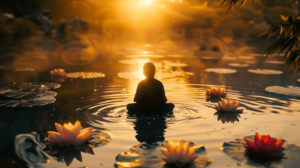Introduction

Imagine a person standing in front of a beautiful mountain range. The grandeur of the peaks, the vastness of the valleys, and the wild beauty of the scene could awaken a sense of awe, reminding them of their place in something far larger than themselves. Yet, if that person is lost in thought, replaying past regrets or worrying about the future, they miss this moment entirely. Their attention is confined to a world within—a world constructed by the mind, one where thoughts run endlessly like a spinning wheel, dragging their awareness away from the beauty right before them. This is the experience for most people: we live in an almost ceaseless stream of thoughts, stories, judgments, and expectations, often unaware of the possibility of a reality beyond this mental realm.
The egoic mind, a term used to describe the part of us that identifies with thoughts and emotions, keeps us anchored in this internal world of constant commentary. This “ego” thrives on separation, on the idea of “me” versus “the world,” or “my thoughts” versus “reality.” It builds an identity around thoughts and emotions, holding tightly to beliefs and narratives that define who we think we are. This is not a peaceful place to live. In fact, it can be profoundly limiting and even painful. The more we identify with the egoic mind, the more we become trapped in a narrow, isolated experience of reality, cut off from the richness of life that exists beyond mental constructs.
This raises a fundamental question: what if true peace is not about controlling the mind, as many assume, but about transcending it altogether? What if the real journey is not to still the mind but to dissolve the illusions that keep us identified with it?
The Myth of Mind Control: Why Stillness is Not the Final Goal
For many on a spiritual path, the idea of a “still mind” becomes the ultimate goal—a sanctuary free from mental noise where peace reigns supreme. Techniques to calm the mind, like meditation, breathwork, or mindfulness, are seen as paths to reach this elusive state. And while these practices are indeed valuable, they are not the final destination. Achieving stillness is like calming a lake’s surface: the waters may settle, but the lake itself, with its depths and boundaries, remains intact. Similarly, a still mind might offer temporary peace, but the ego remains underneath, ever-present, ready to rise again.
Transcending the mind, however, is a fundamentally different journey. It is not about temporarily quieting thoughts but about moving beyond the structure that gives rise to the thoughts themselves. Imagine for a moment that the lake—representing the egoic mind—is drained entirely, revealing the spacious landscape that exists without it. This is the experience of moving beyond thought: there is no longer a need to calm the mind because one no longer identifies with it as “me.” Thoughts might arise, but they are like passing clouds, not anchored to a sense of self. They come and go, without attachment, without drawing us into their story.
The distinction between stilling the mind and dissolving the mind is subtle but profound. When we try to control the mind, we are still within its boundaries, working to manage or suppress aspects of it. But when we dissolve identification with the mind, we transcend those boundaries entirely. The lake no longer needs to be calm, because we no longer see ourselves as the lake. This shift, though challenging to grasp at first, opens the doorway to an experience of reality that is far more expansive, vivid, and peaceful than anything we could achieve through mere mind control.
Practical Insight: The Journey from Control to Transcendence
To make this shift from controlling the mind to transcending it, we must first observe the nature of our thoughts and how we respond to them. In moments of mental quiet, many of us might feel a temporary relief, a glimpse of peace. However, when a thought suddenly arises, it might be tempting to push it down or to return to a technique that calms it. This response, though well-intentioned, keeps us bound to the mind’s cycle of control and suppression.
Instead, consider allowing thoughts to arise without judgment, noticing them without trying to manipulate them. Watch them with curiosity, as though they are external objects with no real bearing on who you are. This simple practice, though it requires patience and gentleness, begins to create distance between “you” and “your thoughts.” The process may feel uncomfortable at first, as the mind will resist relinquishing control. But as this distance grows, so does a sense of inner spaciousness—a quality of awareness that exists independently of the mind’s activity.
By practicing this type of non-attachment, you start to see that thoughts do not need to be silenced or controlled; they merely need to be observed and left alone. Over time, this shift can naturally lead to moments of transcendence, where thoughts arise within an expansive awareness that remains unmoved by them. The mind becomes a passing phenomenon, not an entity that defines or limits your experience.
Illuminating the Darkness: The Role of the Shadow in Transcending the Egoic Mind
To dissolve the egoic mind, it is essential to understand the hidden dimensions of our inner world, often referred to as the “shadow.” The shadow includes those parts of ourselves we reject or suppress—painful memories, unresolved traumas, fears, and unconscious biases. These hidden aspects do not simply disappear; rather, they remain active within the psyche, feeding the ego’s sense of separation, fear, and control. The ego draws strength from these buried parts, creating a false sense of identity built around avoidance and denial.
Integrating the shadow is, therefore, a powerful step toward transcending the egoic mind. This involves bringing unconscious aspects into the light of awareness, where they can be acknowledged, accepted, and ultimately integrated. For example, a person who fears vulnerability might unconsciously create a self-image centered on strength and independence. The ego, in this case, thrives on the avoidance of vulnerability, constructing a personality that is rigid and guarded. When such a person begins to face this hidden fear, allowing themselves to feel vulnerable, they start dismantling the ego’s grip, making space for authentic presence.
Shadow work involves facing these unresolved parts without judgment. It requires a gentle curiosity and a willingness to feel uncomfortable emotions, recognizing that these experiences are not indicators of failure or inadequacy but gateways to liberation. This process is accessible for all, regardless of spiritual background, yet it also offers profound insights for advanced practitioners who might still hold subtle attachments to their own self-image. Integrating the shadow is a process of becoming whole—a necessary step in moving beyond the egoic mind and experiencing a life unencumbered by internal division.
Practical Insight: Working with the Shadow
To begin shadow work, start by noticing recurring emotional triggers or reactions in daily life. These moments, though often uncomfortable, reveal hidden aspects of the self that seek integration. When faced with such reactions, resist the urge to suppress or justify them. Instead, ask gentle questions: What am I feeling? Why does this situation bring up discomfort? What part of myself am I rejecting or denying here? This process is not about finding immediate answers but about opening a compassionate space within, allowing suppressed aspects to surface naturally.
For instance, if a feeling of jealousy arises, avoid immediately judging it as “bad” or attempting to push it away. Instead, explore it with curiosity, asking what this feeling reveals about unmet needs, unhealed wounds, or hidden insecurities. Over time, this compassionate observation transforms the shadow into an ally, revealing hidden dimensions of the self that, when embraced, dissolve the ego’s hold over one’s identity.
The Direct Path to Reality: Unmediated Experience and the End of the Illusory Self
Once we begin integrating our shadow aspects, a new dimension of presence opens up. With fewer unresolved emotions fueling the egoic mind, we start to experience moments of pure awareness—a state of being that is unfiltered, unmediated, and deeply alive. In these moments, thoughts may still arise, but they are no longer experienced as “mine.” They are simply phenomena passing through awareness, much like sounds or colors. The egoic mind, which once felt inseparable from our identity, begins to loosen its grip.
Imagine being fully immersed in nature: the gentle rustling of leaves, the warmth of sunlight, the scent of earth. In such moments, thoughts might still come and go, yet there is a profound shift in the way they are experienced. Rather than clinging to thoughts or becoming entangled in their narratives, we observe them from a place of stillness. This is unmediated reality, a space where thoughts no longer dominate our experience, and the egoic self fades into the background.
Experiencing reality in this way is profoundly freeing. The filters of judgment, expectation, and attachment that color ordinary perception begin to fall away, leaving us open to life as it is. There is a spaciousness, an aliveness, that is both simple and miraculous. In these moments, we come to realize that our true nature is not the egoic mind but the pure awareness in which all experiences arise and dissolve. This awareness, unlike the fleeting nature of thoughts, is stable, vast, and untouched by the ups and downs of the mental world.
Practical Insight: Cultivating Unmediated Presence
Cultivating unmediated presence starts with observing your immediate experience without labeling or judging. Find a quiet space, perhaps in nature or during a quiet moment in the day, and allow yourself to simply be. Notice thoughts as they arise, but rather than following them, let them pass like clouds drifting through an open sky. Shift your attention to the sensory details around you—the sounds, colors, textures, and sensations—and feel them without commentary.
With practice, this form of presence reveals the true nature of awareness: a vast, spacious consciousness that contains thoughts without being defined by them. At first, it may feel subtle, even elusive, but over time, this practice deepens, offering glimpses of reality unmediated by mental constructs. This is not a “technique” to achieve something but rather an invitation to relax into the ever-present awareness that already exists beneath the surface of the mind.
In this section, we’ve delved into the powerful practices of shadow work and unmediated presence, each offering a pathway toward the dissolution of the egoic mind. These practices build upon each other, guiding readers to move beyond identification with thought and into a space of profound, spacious awareness—a glimpse into the next section’s exploration of authentic transcendence and living beyond thought.
Transcendence vs. Suppression: The Pitfalls of Delusional Silence
As we venture further into transcending the egoic mind, one of the greatest obstacles lies in mistaking suppression for true transcendence. The journey toward inner peace often leads people to quiet their minds, silencing uncomfortable thoughts and emotions. However, merely suppressing the mind’s activity is a temporary fix; it doesn’t touch the root of the egoic mind. In reality, suppression can lead to what we might call “delusional silence”—a false calm that masks the unresolved layers of ego. This is an all-too-common pitfall in spiritual practice, where the ego subtly hides behind a façade of “mind silence.”
Authentic transcendence, by contrast, is not about silencing thoughts by force or pushing emotions aside. It is about freeing oneself from the need to control or suppress. Instead of forcing silence, authentic transcendence allows thoughts and emotions to arise naturally, while remaining unentangled in their stories or identities. This is the difference between trying to shut out the world from a quiet room and stepping out into a vast open field, where every sound and sight is experienced without resistance or attachment.
Learning to discern between suppression and transcendence is essential for deep spiritual growth. For example, if feelings of anger or sadness arise, suppression might attempt to bury them, presenting a forced state of calm. True transcendence, on the other hand, observes these feelings without attempting to modify or label them, allowing them to pass like waves. This approach doesn’t require “doing” anything to silence the mind; instead, it involves shifting into a state of pure presence that sees through the ego’s need to control or label. In this way, authentic transcendence arises not from suppression, but from a profound release of attachment to the mind’s activities.
Practical Insight: Recognizing Authentic Transcendence
To cultivate this discernment, observe your response the next time you experience an emotional or mental reaction. Notice if there is an urge to push the feeling away or to “fix” it. Instead of reacting, pause and allow the feeling or thought to exist without judgment. Treat it as a natural phenomenon, like a gust of wind passing through. With time, this approach dissolves the urge to suppress and reveals a calm that is born not from control but from acceptance. This acceptance becomes a doorway to true freedom, allowing transcendence to arise organically.
The Ascension of Identity: From Thought to Pure Awareness
When we no longer feel compelled to control or identify with the mind’s activity, a subtle yet profound shift in identity begins to unfold. We transition from seeing ourselves as the sum of our thoughts and emotions to experiencing ourselves as pure awareness—the spacious consciousness in which all thoughts, emotions, and sensations arise and dissolve. This ascension of identity represents one of the most significant shifts on the spiritual path. Instead of clinging to the stories or narratives we once used to define ourselves, we come to know ourselves as the witness, the observer that is ever-present, unchanging, and free.
This realization is akin to stepping behind the scenes of a play you’ve always thought you were performing in. Suddenly, you are no longer the character on stage, entangled in the drama and driven by a scripted identity. You are the audience, watching with clarity, perspective, and detachment. From this vantage point, life unfolds naturally, but without the emotional turbulence that arises when we are caught up in the story.
The beauty of this shift is that it is subtle, often arising slowly and organically. Thoughts continue to arise, emotions still appear, and life’s challenges don’t vanish—but there is no longer an identification with these phenomena. Instead, they become passing waves on the surface of a vast, undisturbed ocean of awareness. This experience is not about transcending the human experience, but about realizing that the human experience is just one layer of a much deeper and more expansive self.
Practical Insight: Shifting into the Role of the Observer
To cultivate this shift, begin by setting aside time each day to observe your thoughts as they arise. Imagine that each thought is like a leaf floating down a river; you are not the leaf, nor the river, but the space through which it flows. Remind yourself that every thought, every sensation, and every experience is witnessed by a part of you that is boundless and undisturbed. With practice, this sense of spaciousness becomes familiar, a natural resting place for your awareness.
Conclusion: Living in the Light of Pure Awareness
Reaching this state of pure awareness brings a profound shift in the way we live. Freed from the incessant pull of thoughts, judgments, and emotions, life takes on a vibrancy that is rarely experienced in the state of ego identification. This is the essence of living beyond thought—existing in a state of presence that is untouched by the mind’s stories, biases, and fears. In this way, life becomes an unfiltered experience, rich in depth and clarity.
Living from pure awareness doesn’t mean retreating from the world or becoming emotionless. On the contrary, it means engaging with life from a place of total presence, where emotions, thoughts, and experiences are seen as transient waves in the vast ocean of awareness. This way of being doesn’t demand that we renounce the world, but rather that we renounce our attachment to the ego’s illusions. As we do so, we find ourselves free to fully embrace life in all its forms, knowing that our true nature remains unaffected by external circumstances.
Imagine the simplicity of living from this place: moments of joy are celebrated, moments of pain are felt without resistance, and even the mundane becomes meaningful. The present moment becomes a canvas of endless possibility, free from the distortions of past regrets and future anxieties. Each experience is encountered fully, yet without attachment or aversion. This is the promise of pure awareness, a state in which the mind is not silenced by force but naturally quieted by the vastness of presence.









